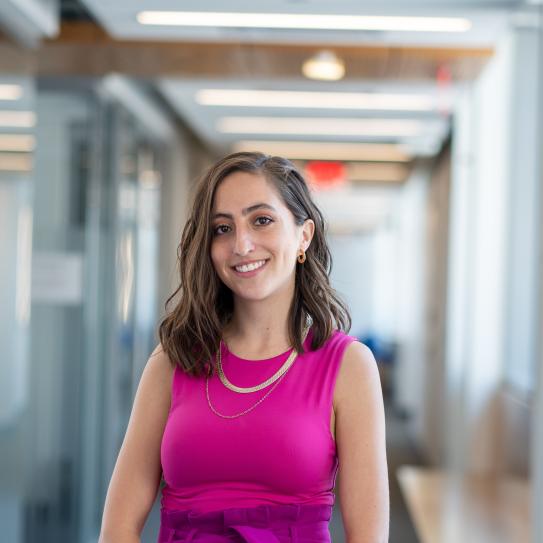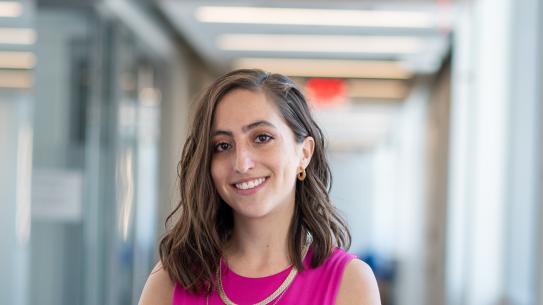Analaura Tostado

[The MS in Applied Urban Science and Informatics] seemed like the perfect blend of urban planning and technology. I believed it would provide the best prospects for my future career and allow me to explore beyond the confines of architecture.“
We spoke with Analaura about how earning her MS in Applied Urban Science and Informatics helped to shape her future career aspirations. Read our interview for more insights about what it's like to be a student at CUSP!
What was growing up in Mexico like for you, and what initially led you to decide on a career path?
Growing up in Mexico, I developed a keen interest in design and excelled in math and physics. I dreamed of becoming an astronaut but soon realized that pursuing that path would be challenging in Mexico because there weren’t many opportunities. However, my passion for creativity persisted, so I began exploring other avenues that could blend my interests. During junior high, I took a technical drawing class taught by an architect that sparked my interest in architecture. My teacher remarked on my potential while I was working on a drawing, and that moment had a profound impact on me.
I discovered that architecture perfectly combined my interests in math, physics, and design, making it the ideal career for me. Despite initial doubts about my creativity, I enrolled in university to study architecture and quickly realized my passion for the work. Looking back, I am certain that architecture was the right choice, allowing me to merge my design skills with my love for math and physics while making a positive impact on people’s lives. It allowed me to push my creativity further, and contribute meaningfully to the built environment.
What was it like to work as an architect?
After graduating, I began my career as an architect with a diverse range of projects. Initially, I worked on high-end residential designs during my internship at a specialized firm, gaining valuable experience for about 7 months. Following that, I joined a smaller firm where I focused on designing office spaces, working on projects for notable clients like MINISO. Spending another year there, I honed my skills in office architecture.
Later on, I transitioned to Irongate, a non-traditional architecture firm within the real estate development industry. They were developing the Costa Palmas resort project in Los Cabos, Mexico and decided to establish an in-house design team. I was fortunate to be hired and spent three years working on designing houses for the resort’s Four Seasons rental pool. This opportunity exposed me to larger-scale projects and the entire design-to-construction process. Plus, I had the chance to travel regularly to Los Cabos, which was exciting.
What factors motivated you to pursue a master's degree and ultimately led you to NYU CUSP?
After five years of working as an architect, I felt a strong desire to expand my professional horizons. I was particularly curious about urban design and planning, as my undergraduate studies had introduced me to that field. Plus, I had always wanted to pursue a master’s degree in general. While contemplating my next steps, I began researching master’s programs that aligned with my interest in urban design. That’s when I stumbled upon the CUSP program at NYU. It seemed like the perfect blend of urban planning and technology, which intrigued me. Despite my limited experience in programming and analytics, I saw it as an exciting opportunity to expand my skills, so I applied.
Alongside NYU, I also received offers to other similar programs at Northeastern, and UCLA. While UCLA and the west coast was tempting, the vibrant cities of Boston and New York drew me in. After careful consideration, I chose to join the CUSP program at NYU. I believed it would provide the best prospects for my future career and allow me to explore beyond the confines of architecture.
During my search, I also discovered the Fulbright scholarship program and decided to apply. After completing an interview and waiting patiently for a few weeks, I finally found out that I had been awarded the prestigious Fulbright scholarship, opening the doors to furthering my education and professional development.
How did you prepare for the challenges of learning technical skills at CUSP?
Before committing to the program, I took a quick Python introductory course to see if I would like it. I remember taking some technology classes in high school but didn’t enjoy coding at that time. However, when I learned about the significance of data analysis in the CUSP program, I decided to give it another chance. Taking the Python course changed my perspective, and I discovered a newfound interest in understanding how things work through coding. Additionally, I participated in the summer boot camp offered by the program to further prepare myself. Despite occasional challenges and doubts, I embraced the learning process and gained a solid foundation for my studies at CUSP.
What classes or experiences at NYU have helped you to further pursue your goals?
At NYU, my journey has been filled with exciting classes and experiences that have propelled me towards my goals. One standout class was the Civic Analytics course, taught by Professor Tracy Jo Ingram, which opened my eyes to the abundance of waste on the streets of New York. This led me to focus my project for the course on understanding the waste management system, specifically organic waste collection. I proposed conducting a comprehensive analysis to determine the optimal locations for new organic waste collection bins using machine learning or similar algorithms. Additionally, I envisioned creating a mobile app that would provide information on bin locations, including their fill levels. The app would also feature a scanning function, allowing users to identify the appropriate waste category for specific items. Overall, my project aimed to improve waste management by increasing accessibility, participation, and awareness.
I ended up submitting my work to a few competitions and won 1st place in Global Talent Week’s category for Sustainable Cities and Communities (SDG11) and 2nd place at the Tandon Research Expo. This exploration and development of a tangible solution to a real problem in NYC was both enlightening and rewarding

Additionally, the Urban Decision Models class, taught by Professor Lucius Riccio, was really helpful. Professor Riccio’s teaching style made the classes engaging, and we developed skills in using Excel for urban decision-making.
Overall, my time at NYU has been marked by positive learning experiences and valuable insights. I’m grateful for the knowledge I’ve gained so far, and I’m eager to continue my educational journey, further honing my skills in urban planning and data analysis.
You also are taking a course on disaster risk. How did that deepen your understanding of building resilient communities?
I’ve always been fascinated by earthquakes and similar phenomena, driving my curiosity to understand them better. So when I discovered the disaster risk class, it immediately caught my attention. This course teaches us how to model and predict the outcomes of natural disasters, assessing the associated risks. For instance, we analyze the potential effects of an earthquake of a certain magnitude in a specific area, estimating building damage and other impacts. This knowledge enables us to take preventive measures and plan for disaster mitigation.
Studying these topics has practical applications in building resilient communities. Although it has been challenging since I hadn’t worked with probabilities and statistics since high school, I find the subject matter incredibly engaging. I enjoy the process of reacquainting myself with these concepts and learning how to apply them to real-world scenarios.
All CUSP students complete capstone projects as part of their master’s degree, where they partner with a sponsor to work on solving an urban challenge that’s happening in a city in real time. What is the focus of your capstone project, and how is it contributing to your overall learning experience?
My capstone project is focused on “Understanding the True Cost of Vacant Properties in Baton Rouge.” It involves assessing the economic impact of vacant properties and utilizing data analysis and technology to revitalize communities. We are currently in the early stages of data analysis, gathering information on vacant properties and assessing their maintenance cost. We are also exploring the development of a GIS tool that contains all the relevant information about vacant properties and its cost per year. This tool aims to help the government, the community, and interested stakeholders to identify areas for intervention and benefit the community. Working on this capstone project has allowed me to apply data analysis techniques to real-world challenges and gain insights into the complexities of community revitalization through data-driven solutions, which is something I am interested in implementing in Mexico.
What advice would you give to other students who are pursuing similar paths or entering the field of urban science?
One thing I would suggest is to really get a good grasp of basic statistics and understand what is happening with all the data. It can be overwhelming if you’re not prepared, since every class continues to build upon those skills. Additionally, take advantage of all the resources available. We often take them for granted, but there are numerous opportunities. Reach out to faculty members and even your fellow students. Discuss your interests and work on them. There’s always a resource that can help you!


